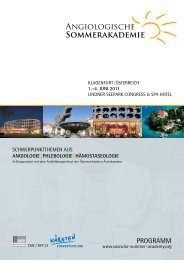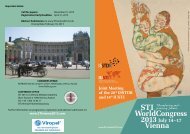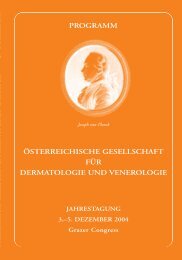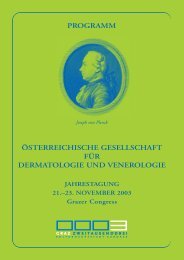PROGRAMM JAHRESTAGUNG 2012 30. Nov. – 2. Dez ... - ÖGDV
PROGRAMM JAHRESTAGUNG 2012 30. Nov. – 2. Dez ... - ÖGDV
PROGRAMM JAHRESTAGUNG 2012 30. Nov. – 2. Dez ... - ÖGDV
Erfolgreiche ePaper selbst erstellen
Machen Sie aus Ihren PDF Publikationen ein blätterbares Flipbook mit unserer einzigartigen Google optimierten e-Paper Software.
Poster Wundheilung<br />
P 49<br />
Gene expression studies on the mechanisms of impaired wound healing in<br />
recessive dystrophic epidermolysis bullosa<br />
Jenny Breitenbach 1<br />
Christina Gruber 1<br />
Andrea Trost 2<br />
Barbara Bogner 2<br />
Helmut Hintner 1<br />
Johann Bauer 1<br />
1 SALK/Paracelsus Medical University Salzburg Laboratory for Molecular Therapy, EB<br />
House Austria Department of Dermatology, Muellner Hauptstraße 48,<br />
A-5020 Salzburg<br />
2 SALK/Paracelsus Medical University Salzburg Department of Ophthalmology and<br />
Optometry, Muellner Hauptstraße 48, A-5020 Salzburg<br />
Introduction: In recessive dystrophic epidermolysis bullosa (RDEB), wound healing is<br />
severely impaired with persistent inflammation, chronic wounds, and atrophic scars<br />
caused by repeated friction and infections. Almost all RDEB patients develop<br />
pseudosyndactyly with contractures leading to the loss of finger function, and so far,<br />
there is no treatment that permanently relieves this complication.<br />
Methods and results: Our main goal is to elucidate the mechanisms underlying<br />
scarring and pseudosyndactyly in order to contribute to improving those symptoms<br />
in RDEB. To this end, we performed a genome wide study of gene expression in scarring<br />
and non scarring skin of RDEB patients and healthy persons by cDNA microarrays in<br />
order to identify new genes that are involved in the wound healing process in RDEB<br />
patients. We found numerous genes and functional gene groups with specific differential<br />
regulation in RDEB scars, among them such associated with wound healing,<br />
inflammation, the cytoskeleton, and neuronal function and development. We also<br />
detected a similar gene expression pattern in non scarring skin from RDEB patients and<br />
in scar tissue from healthy donors, indicating permanent increased inflammation and<br />
tissue remodeling in RDEB. Furthermore, we saw that in RDEB patients mostly genes<br />
involved in inflammation, tissue remodeling, and skin development were differentially<br />
regulated. Some of these genes were confirmed by semi-quantitative real time-PCR.<br />
Data mining revealed specific differential regulation of members of the PDGF signaling<br />
pathway in RDEB scars, the TGF-β pathway in scars from healthy persons and RDEB<br />
patients, and the Wnt pathway in scars from healthy persons and RDEB patients and in<br />
non scarring RDEB skin. Since in an RDEB mouse model Fritsch et al. (2008) found<br />
pseudosyndactyly accompanied by accumulation of the fibrosis markers α-SMA and<br />
TN-C in the skin, we also studied the role of those proteins in finger contractures in<br />
human RDEB patients by immuno fluorescence microscopy of tissue from affected<br />
digits. We confirmed strong upregulation of TN-C in RDEB scar skin. However, the<br />
myofibroblast marker α-SMA was not changed.<br />
106









